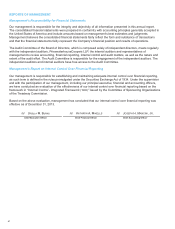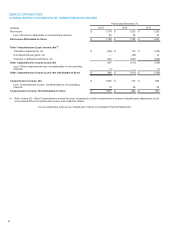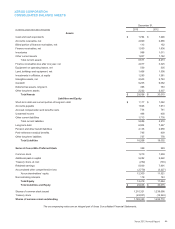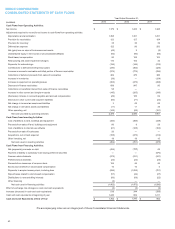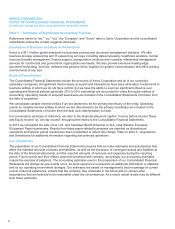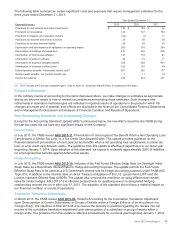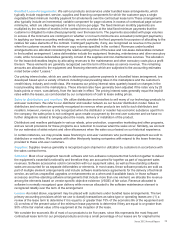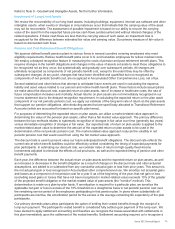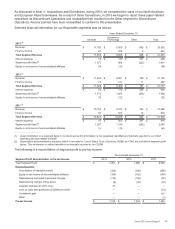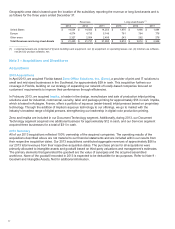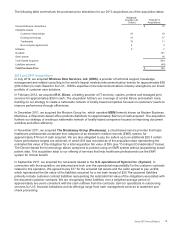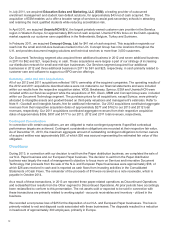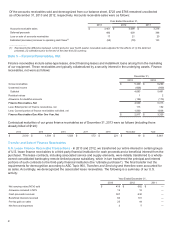Xerox 2013 Annual Report Download - page 88
Download and view the complete annual report
Please find page 88 of the 2013 Xerox annual report below. You can navigate through the pages in the report by either clicking on the pages listed below, or by using the keyword search tool below to find specific information within the annual report.longer than five years. There is no significant after-market for our used equipment. We believe five years is
representative of the period during which the equipment is expected to be economically usable, with normal service,
for the purpose for which it is intended. Residual values are not significant.
With respect to fair value, we perform an analysis of equipment fair value based on cash selling prices during the
applicable period. The cash selling prices are compared to the range of values determined for our leases. The
range of cash selling prices must be reasonably consistent with the lease selling prices in order for us to determine
that such lease prices are indicative of fair value.
Financing: Finance income attributable to sales-type leases, direct financing leases and installment loans is
recognized on the accrual basis using the effective interest method.
Services-Related Revenue
Outsourcing: Revenues associated with outsourcing services are generally recognized as services are rendered,
which is generally on the basis of the number of accounts or transactions processed. Information technology
processing revenues are recognized as services are provided to the customer, generally at the contractual selling
prices of resources consumed or capacity utilized by our customers. In those service arrangements where final
acceptance of a system or solution by the customer is required, revenue is deferred until all acceptance criteria
have been met. Revenues on cost reimbursable contracts are recognized by applying an estimated factor to costs
as incurred, determined by the contract provisions and prior experience. Revenues on unit-price contracts are
recognized at the contractual selling prices as work is completed and accepted by the customer. Revenues on time
and material contracts are recognized at the contractual rates as the labor hours and direct expenses are incurred.
Revenues on certain fixed price contracts where we provide system development and implementation services are
recognized over the contract term based on the percentage of development and implementation services that are
provided during the period compared with the total estimated development and implementation services to be
provided over the entire contract using the percentage-of-completion accounting methodology. These services
require that we perform significant, extensive and complex design, development, modification or implementation of
our customers' systems. Performance will often extend over long periods, and our right to receive future payment
depends on our future performance in accordance with the agreement.
The percentage-of-completion methodology involves recognizing probable and reasonably estimable revenue using
the percentage of services completed, on a current cumulative cost to estimated total cost basis, using a reasonably
consistent profit margin over the period.
Revenues earned in excess of related billings are accrued, whereas billings in excess of revenues earned are
deferred until the related services are provided. We recognize revenues for non-refundable, upfront implementation
fees on a straight-line basis over the period between the initiation of the ongoing services through the end of the
contract term.
In connection with our services arrangements, we incur and capitalize costs to originate these long-term contracts
and to perform the migration, transition and setup activities necessary to enable us to perform under the terms of
the arrangement. Certain initial direct costs of an arrangement are capitalized and amortized over the contractual
service period of the arrangement to cost of services.
From time to time, we also provide inducements to customers in various forms, including contractual credits, which
are capitalized and amortized as a reduction of revenue over the term of the contract. Customer-related deferred
set-up/transition and inducement costs were $399 and $356 at December 31, 2013 and 2012, respectively, and the
balance at December 31, 2013 is expected to be amortized over a weighted average period of approximately 6
years. Amortization expense associated with customer-related contract costs at December 31, 2013 is expected to
be approximately $132 in 2014.
Long-lived assets used in the fulfillment of the arrangements are capitalized and depreciated over the shorter of
their useful life or the term of the contract if an asset is contract specific.
Our outsourcing services contracts may also include the sale of equipment and software. In these instances we
follow the policies noted above under Equipment-Related Revenue.
71


